Study of the Greenhouse Gas Emissions from Electric Buses Powered by Renewable Energy Sources in Poland
Abstract
1. Introduction
- Well-to-tank (WTT) analysis, in which one is to consider the environmental burdens associated with the sourcing of the raw material from which fuel is produced, the fuel production itself, as well as its transport and storage.
- Tank-to-wheel (TTW) analysis, in which one is to consider the environmental burdens associated with the fuel consumption by means of transport, as well as the refuelling and fuel combustion associated with vehicle operation.
2. Methodology of Analysis
3. Assumptions and Data Inventory
- Distance travelled in each month of the analysis.
- Fuel consumption—diesel fuel, including fuel consumed for bus heating.
- Emissions of gas and dust pollutants according to the emission standards applicable to 12 m buses: Euro 6.
- Distance travelled in each month of the analysis.
- Fuel (electricity) consumption for battery charging.
- Diesel fuel consumption for bus heating.
- Gas and dust emissions from diesel fuel consumption for heating of 12 m buses: Euro 6.
4. LCA Results
4.1. Assessment of Greenhouse Gas Emissions from Diesel Fuel
4.2. Assessment of Greenhouse Gas Emissions from Electric Buses
4.3. Greenhouse Gas Emissions Assessment from Electric Buses and Diesel Fuel Buses with Euro 6 Standards
4.4. Impact of RES Share in Energy Mix on the GHG Emissions of the Electric Buses
5. Results and Discussion
6. Summary and Conclusions
- The greatest benefits in terms of greenhouse gas emission reduction can be achieved in public bus transport by replacing conventionally powered vehicles with electric vehicles, yet only under the condition that the energy consumed to power them comes from renewable energy sources. Adding renewable energy sources to the energy mix used for charging electric bus batteries reduces total GHG emissions. For the RES fractions of 25%, 50%, and 75% in the energy mix, emission reductions of approx. 19%, 38%, and 57% have been achieved, respectively. For an energy mix entirely derived from RESs, the reduction in emissions comes to ca. 76% vis-à-vis Poland’s energy mix in 2022.
- Due to significant additional greenhouse gas emissions, especially in the winter months, electric buses should be operated without diesel heating systems. Unfortunately, such heating solutions in electric buses are currently often used in Poland, due to the lower purchase price of the bus. Currently, an alternative may be electric buses with modern electric heating systems combined with a heat pump.
- Currently used electric buses in Poland are charged with an energy mix that mainly comes from coal-fired power plants. This unfavourable situation should improve, because according to the adopted assumptions of the energy policy, the importance of renewable energy sources (RESs) in Poland is to systematically grow in the coming years, reaching a 39.5% share in the structure of domestic electricity consumption in 2040.
Author Contributions
Funding
Data Availability Statement
Conflicts of Interest
References
- European Environment Agency. Trends and Projections in Europe 2023; EEA Report No. 7/2023; European Environment Agency: Copenhagen, Denmark, 2023. [Google Scholar]
- Road Transport in Poland in 2020 and 2021. Statistical Analyses Central Statistical Office, Warsaw-Szczecin, 2023. Available online: https://stat.gov.pl/en/topics/transport-and-communications/transport/road-transport-in-poland-in-the-years-2020-and-2021,5,7.html (accessed on 4 March 2025).
- Manisalidis, I.; Stavropoulou, E.; Stavropoulos, A.; Bezirtzoglou, E. Environmental and Health Impacts of Air Pollution: A Review. Front. Public Health 2020, 8, 505570. [Google Scholar]
- Poland Air Quality Management—Final Report. Document of the World Bank, Report No: AUS0000585, 2019. Available online: https://openknowledge.worldbank.org/server/api/core/bitstreams/7d982fea-4878-5fef-89a0-a4b2ff6c7dd0/content (accessed on 4 March 2025).
- Europe’s Air Quality Status 2024. Available online: https://www.eea.europa.eu/publications/europes-air-quality-status-2024 (accessed on 20 January 2025).
- European Environment Agency. Environmental Noise in Europe—2020; EEA Report No 22/2019; European Environment Agency: Copenhagen, Denmark, 2019. [Google Scholar]
- Paris Climate Change Agreement. 2016. Available online: https://unfccc.int/process-and-meetings/the-paris-agreement/the-paris-agreement (accessed on 20 January 2025).
- Communication from the Commission COM(2019) 640_final of 11 December 2019, European Green Deal, 2019. Available online: https://eur-lex.europa.eu/resource.html?uri=cellar:b828d165-1c22-11ea-8c1f-01aa75ed71a1.0002.02/DOC_1&format=PDF (accessed on 4 March 2025).
- Directive 2019/1161 of the European Parliament and of the Council (EU) of 20 June 2019 Amending Directive 2009/33/EC on the Promotion of Clean and Energy-Efficient Road Transport Vehicles. Available online: https://eur-lex.europa.eu/eli/dir/2019/1161/oj/eng (accessed on 4 March 2025).
- Act of 11 January 2018 on Electromobility and Alternative Fuels. Journal of Laws of 2018, Item 317 (Journal of Laws of 2021, Item 110, as Amended), 2018. Available online: https://isap.sejm.gov.pl/isap.nsf/download.xsp/WDU20180000317/U/D20180317Lj.pdf (accessed on 4 March 2025).
- Official Announcement of the Speaker of the Sejm of the Republic of Poland Act of 10 January 2023 Releasing the Uniform Text of the Act on Electromobility and Alternative Fuels (Journal of Laws of 2023, Item 875), 2023. Available online: https://isap.sejm.gov.pl/isap.nsf/download.xsp/WDU20230000875/T/D20230875L.pdf (accessed on 4 March 2025).
- Report of the European Automobile Manufacturers’ Association (ACEA). Available online: https://www.acea.auto/publication/the-automobile-industry-pocket-guide-2023-2024/ (accessed on 4 March 2025).
- Report of the European Automobile Manufacturers’ Association (ACEA). Report Buses Registered over the Year 2022 by Fuel Type. Available online: https://www.acea.auto/files/ACEA_buses_by_fuel_type_full-year-2022.pdf (accessed on 4 March 2025).
- European Commission. European Alternative Fuels Observatory. Available online: https://alternative-fuels-observatory.ec.europa.eu/transport-mode/road/european-union-eu27/vehicles-and-fleet (accessed on 20 January 2025).
- PN-EN ISO 14040:2009; Environmental Management—Life Cycle Assessment—Principles and Framework. ISO: Geneva, Switzerland, 2009.
- PN-EN ISO 14044:2006; Environmental Management—Life Cycle Assessment—Requirements and Guidelines. ISO: Geneva, Switzerland, 2006.
- Ercan, T.; Tatari, O. A hybrid life cycle assessment of public transportation buses with alternative fuel options. Int. J. Life Cycle Assess. 2015, 20, 1213–1231. [Google Scholar]
- Correa, G.; Muñoz, P.M.; Rodriguez, C.R. A comparative energy and environmental analysis of a diesel. hybrid. hydrogen and electric urban bus. Energy 2019, 187, 115906. [Google Scholar] [CrossRef]
- Moro, A.; Helmers, E. A new hybrid method for reducing the gap between WTW and LCA in the carbon footprint assessment of electric vehicles. Int. J. Life Cycle Assess. 2015, 22, 4–14. [Google Scholar]
- Nordelöf, A.; Messagie, M.; Tillman, A.; Ljunggren Söderman, M.; Van Mierlo, J. Environmental impacts of hybrid. plug-in hybrid. and battery electric vehicles—What can we learn from life cycle assessment? Int. J. Life Cycle Assess. 2014, 19, 1866–1890. [Google Scholar]
- Casals, L.C.; Martinez-Laserna, E.; García, B.A.; Nieto, N. Sustainability analysis of the electric vehicle use in Europe for CO2 emissions reduction. J. Clean. Prod. 2016, 127, 425–437. [Google Scholar]
- Hawkins, T.R.; Singh, B.; Majeau-Bettez, G.; Strømman, A.H. Comparative Environmental Life Cycle Assessment of Conventional and Electric Vehicles. J. Ind. Ecol. 2013, 17, 53–64. [Google Scholar]
- Kawamoto, R.; Mochizuki, H.; Moriguchi, Y.; Nakano, T.; Motohashi, M.; Sakai, Y.; Inaba, A. Estimation of CO2 Emissions of Internal Combustion Engine Vehicle and Battery Electric Vehicle Using LCA. Sustainability 2019, 11, 2690. [Google Scholar] [CrossRef]
- Nordelöf, A.; Romare, M.; Tivander, J. Life cycle assessment of city buses powered by electricity, hydrogenated vegetable oil or diesel. Transp. Res. Part D Transp. Environ. 2019, 75, 211–222. [Google Scholar] [CrossRef]
- Final Report for the European Commission, DG Climate Action. Determining the Environmental Impacts of Conventional and Alternatively Fuelled Vehicles Through LCA. Available online: https://climate.ec.europa.eu/system/files/2020-09/2020_study_main_report_en.pdf (accessed on 4 March 2025).
- Burchart-Korol, D.; Folęga, P. Impact of road transport means on climate change and human health in Poland. Promet—Traffic Transp. 2019, 31, 195–204. [Google Scholar] [CrossRef][Green Version]
- Burchart-Korol, D.; Folęga, P. Environmental footprints of current and future electric battery charging and electric vehicles in Poland. Transp. Probl. 2020, 15, 61–71. [Google Scholar]
- Swiss Centre for Life Cycle Inventories. Ecoinvent 2023 Ecoinvent Database V 3.9. 2025. Available online: www.ecoinvent.org (accessed on 4 January 2025).
- IPCC—Intergovernmental Panel on Climate Change, IPCC Fifth Assessment Report. The Physical Science Basis. Available online: http://www.ipcc.ch (accessed on 4 January 2025).
- CO2, SO2, Nox, CO and Total Particulate Matter Emission Rates for Electric Energy, Based on the Information Contained in the National Database on the Emissions of Greenhouse Gases and Other Substances in 2019; National Centre for Emissions Management IOŚ-PIB (KOBiZE): Warsaw, Poland, 2020.
- Emission and Climate Cost Calculator for Means of Public Transport; National Centre for Emissions Management IOŚ-PIB (KOBiZE): Warsaw, Poland, 2020.
- Cost-Benefit Analysis (CBA) of Using Zero-Emission Buses in Providing Public Transport Services Organised by the GZM Metropolis of Upper Silesia and Dąbrowa Basin. Katowice. 2024. Available online: https://bip.metropoliagzm.pl/artykul/34552/132995/analiza-kosztow-i-korzysci-akk (accessed on 4 March 2025).
- Energy Forum, Analyses and Dialogue. Energy Transition in Poland, 2023. Available online: https://www.forum-energii.eu/en/energy-transition-in-poland-2023-edition (accessed on 4 March 2025).
- Ministry of Climate and Environment. Department of Strategies and Analyses, Statistical Information on Electricity, Warsaw, 2023. Available online: https://www.gov.pl/web/klimat/badania-statystyczne (accessed on 4 March 2025).
- Regulation (EU) 2019/1242 of the European Parliament and of the Council of 20 June 2019 Setting CO2 Emission Performance Standards for New Heavy-Duty Vehicles and Amending Regulations (EC) No 595/2009 and (EU) 2018/956 of the European Parliament and of the Council and Council Directive 96/53/EC. Available online: https://eur-lex.europa.eu/eli/reg/2019/1242/oj/eng (accessed on 4 March 2025).
- Poland’s Energy Policy Until 2040. Official Announcement of the Minister of Climate and Environment of 2 March 2021 on the State’s Energy Policy Until 2040. Available online: https://www.gov.pl/web/climate/energy-policy-of-poland-until-2040-epp2040 (accessed on 4 March 2025).
- Update to the National Air Protection Programme Until 2025 (with an Outlook to 2040). Ministry of Climate and Environment, Warsaw, 2021. Available online: https://www.gov.pl/web/klimat/krajowy-program-ochrony-powietrza (accessed on 4 March 2025).
- Kyoto Protocol to the United Nations Framework Convention on Climate Change, Drawn up in Kyoto on 11 December 1997 (Journal of Laws 2005. No. 203. Item 1684), Council Decision 2002/358/EC of 25 April 2002 Concerning the Approval, on Behalf of the European Community, of the Kyoto Protocol to the United Nations Framework Convention on Climate Change and the Joint Fulfilment of Commitments Thereunder (OJ L 130 of 15 May 2002). Available online: https://isap.sejm.gov.pl/isap.nsf/download.xsp/WDU20052031684/O/D20051684.pdf (accessed on 4 March 2025).
- Conclusions of the European Council of 8–9 March 2007. The Conclusions Contained Commitments Later to Be Referred to as 3 × 20. 2007. Available online: https://cire.pl/pliki/2/PKEE-Raport%202030_Raport_czastkowy_4_2008-06-19.pdf (accessed on 4 March 2025).
- Directive 2009/28/EC of the European Parliament and of the Council of 23 April 2009 on the Promotion of the Use of Energy from Renewable Sources and Amending and Subsequently Repealing Directives 2001/77/EC and 2003/30/EC. 5 June 2009, pp. 16–62, Typically Referred to as Renewable Energy Directive (RED). Available online: https://eur-lex.europa.eu/legal-content/EN/TXT/PDF/?uri=CELEX:32009L0028 (accessed on 4 March 2025).
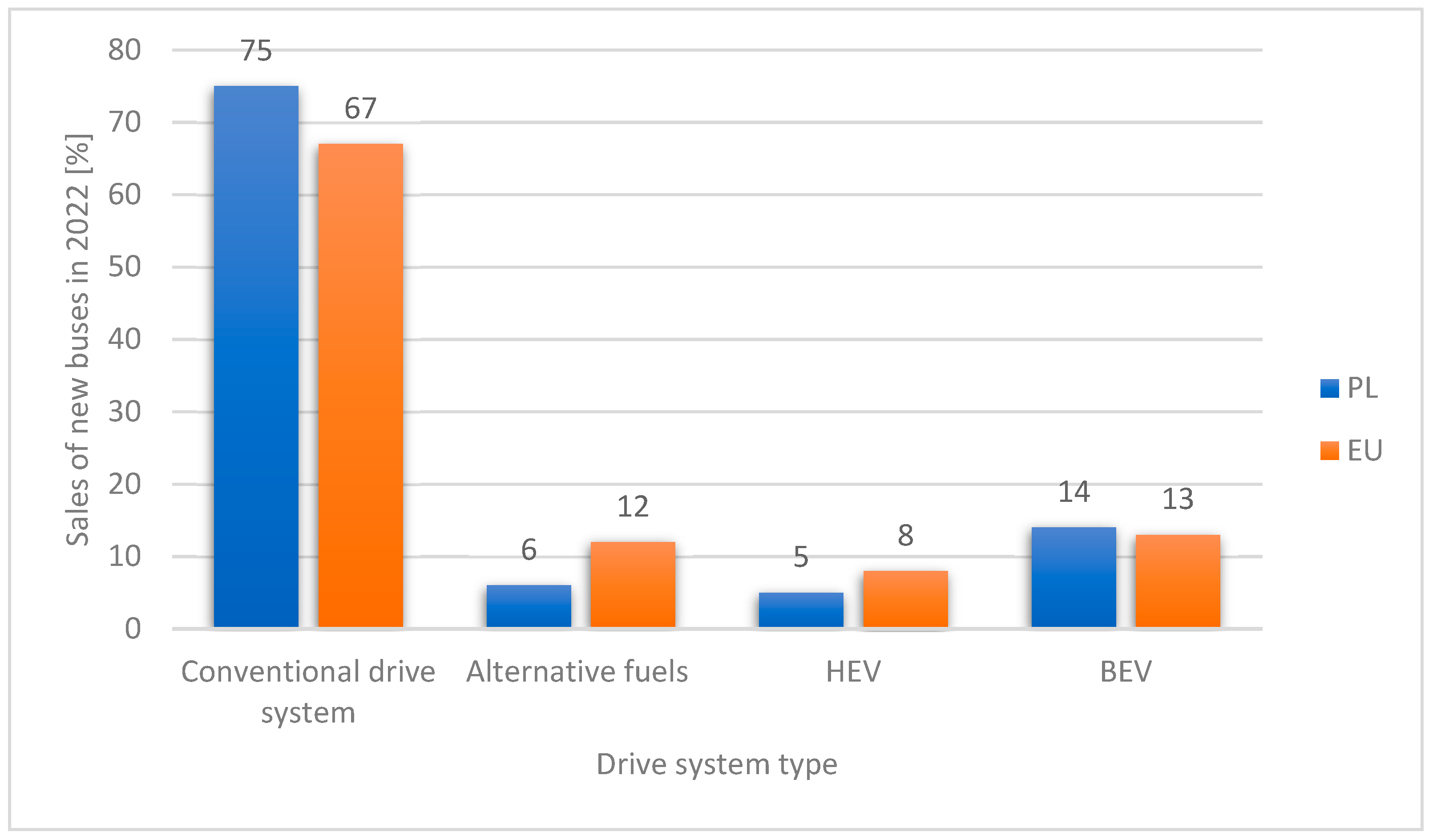
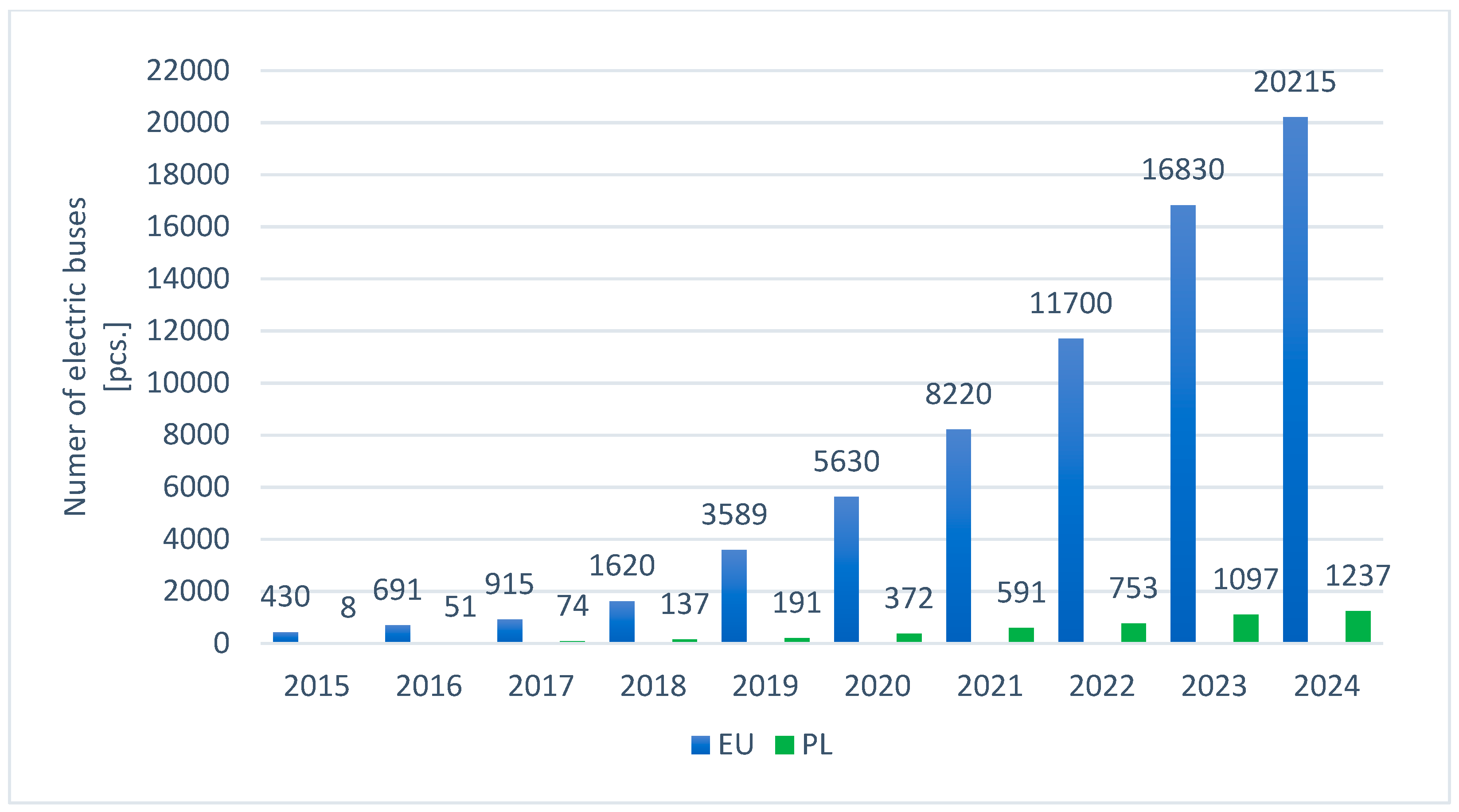


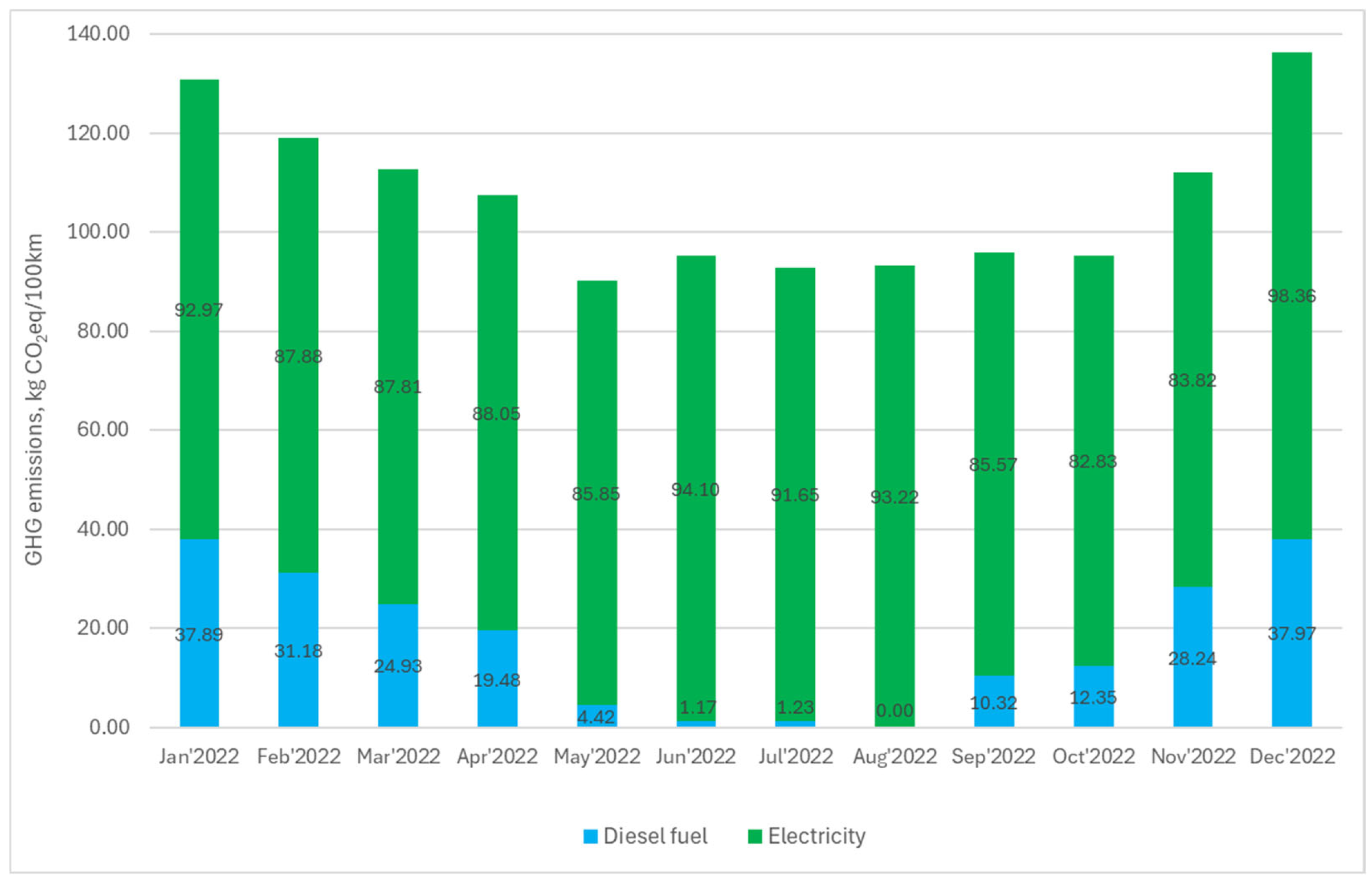
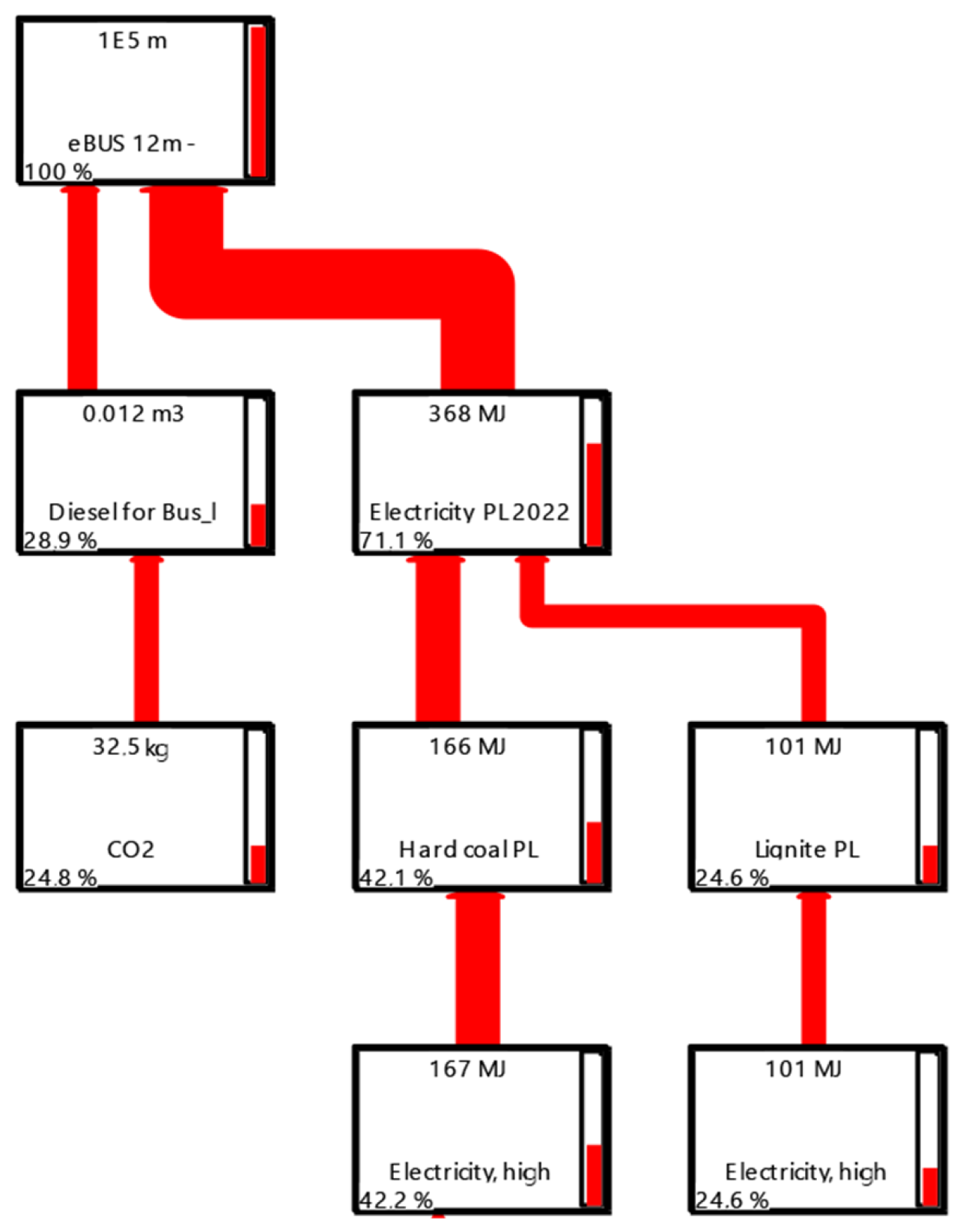
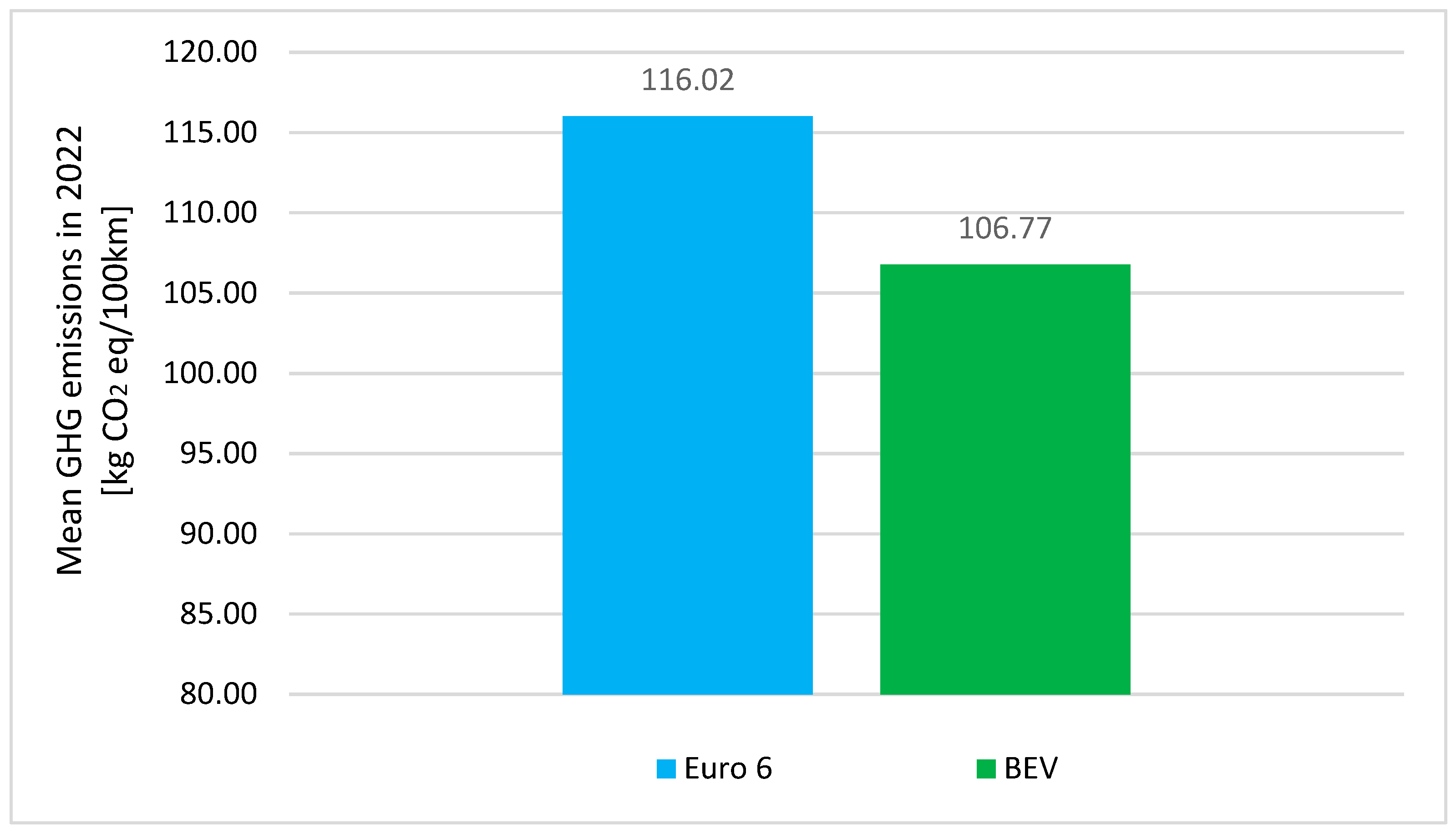



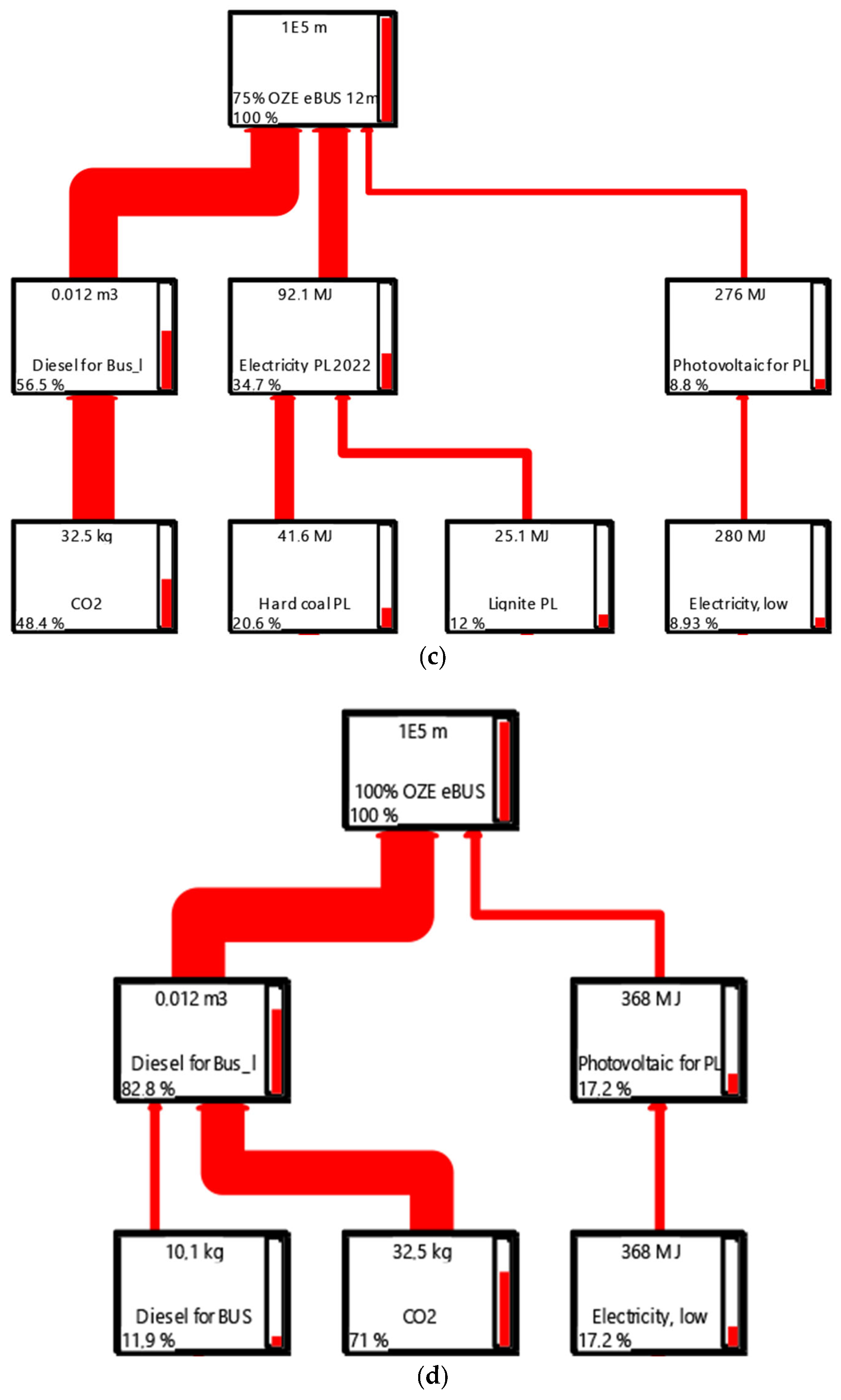
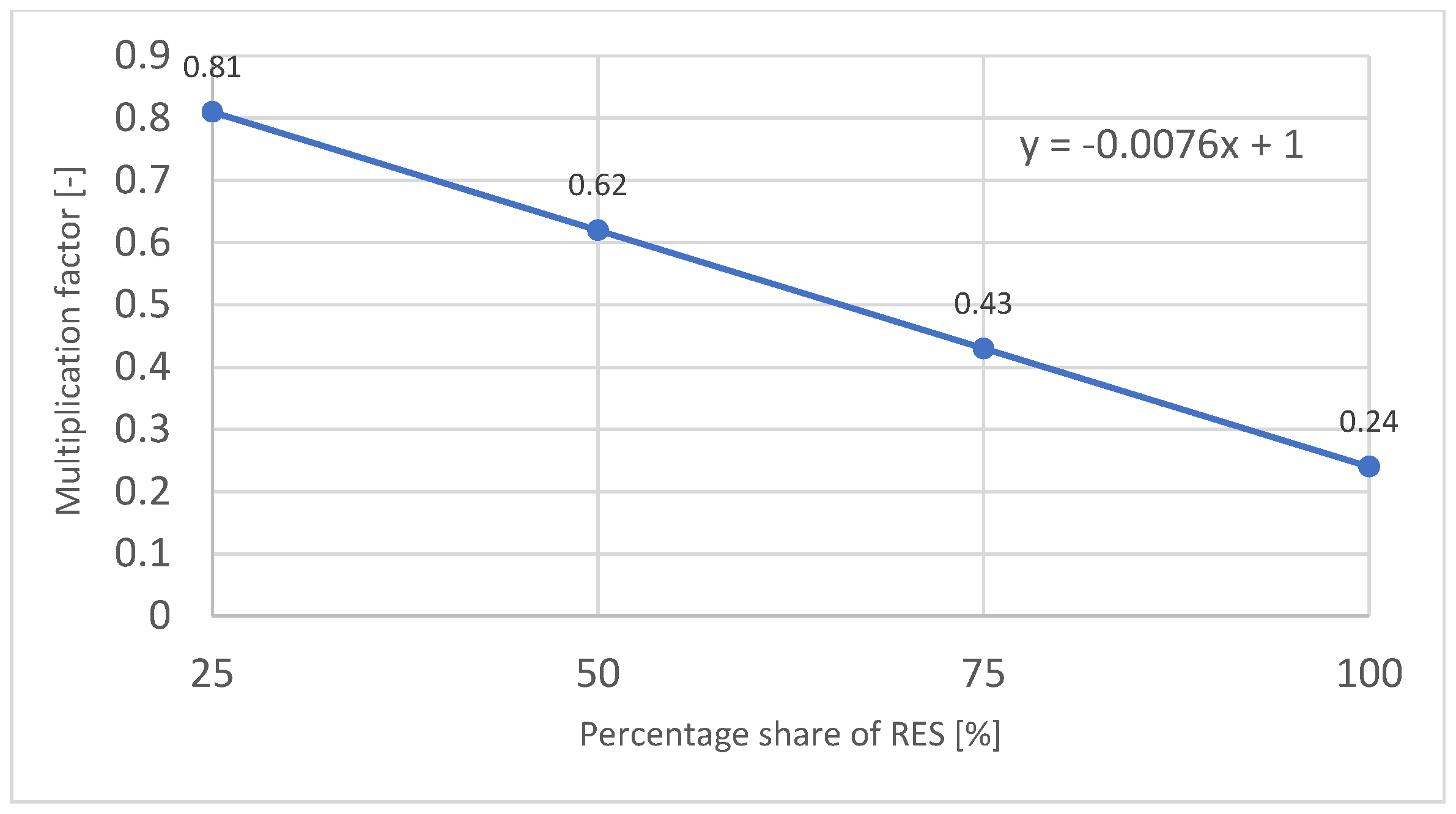
| July | August | September | |||
|---|---|---|---|---|---|
| Distance Travelled [km] | Diesel Fuel [L] | Distance Travelled [km] | Diesel Fuel [L] | Distance Travelled [km] | Diesel Fuel [L] |
| 612,000.00 | 224,096.12 | 593,000.15 | 218,210.31 | 613,784.75 | 223,323.37 |
| October | November | December | |||
| Distance Travelled [km] | Diesel Fuel [L] | Distance Travelled [km] | Diesel Fuel [L] | Distance Travelled [km] | Diesel Fuel [L] |
| 620,392.90 | 228,560.17 | 602,874.45 | 225,984.17 | 614,634.01 | 239,645.57 |
| July | August | September | ||||||
|---|---|---|---|---|---|---|---|---|
| Distance Travelled [km] | Diesel Fuel [L] | Electricity [kwh] | Distance Travelled [km] | Diesel Fuel [L] | Electricity [kwh] | Distance Travelled [km] | Diesel Fuel [L] | Electricity [kwh] |
| 47,616.10 | 185.46 | 48,025.72 | 47,406.60 | 0.00 | 48,632.05 | 51,722.65 | 1694.28 | 48,707.05 |
| October | November | December | ||||||
| Distance Travelled [km] | Diesel Fuel [L] | Electricity [kWh] | Distance Travelled [km] | Diesel Fuel [L] | Electricity [kWh] | Distance Travelled [km] | Diesel Fuel [L] | Electricity [kWh] |
| 52,632.35 | 2063.46 | 47,979.44 | 53,508.90 | 4797.30 | 49,361.66 | 51,524.35 | 6210.71 | 55,771.10 |
| Electricity Source in 2022 | Production [TWh] | Share [%] |
|---|---|---|
| Hard coal | 79 | 44.2 |
| Lignite | 47.3 | 26.5 |
| Gaseous fuel | 11.7 | 6.5 |
| Hydropower | 2 | 1.1 |
| Solar power | 8 | 4.5 |
| Wind power | 19.4 | 10.8 |
| Biogas | 1.4 | 0.8 |
| Biomass | 4.3 | 2.4 |
| Pumped storage power plants | 1.1 | 0.6 |
| Biomass co-firing | 1.9 | 1.0 |
| Other industrial power stations | 2.9 | 1.6 |
| Total | 179 | 100 |
| Fuel Type | Projected RES-Based Electric Energy Production [TWh] | |||||||||||
|---|---|---|---|---|---|---|---|---|---|---|---|---|
| 2025 | 2030 | 2035 | 2040 | |||||||||
| [TWh] | [%] | Total [%] | [TWh] | [%] | Total [%] | [TWh] | [%] | Total [%] | [TWh] | [%] | Total [%] | |
| solar power | 4.5 | 2.4 | 24.6 | 6.8 | 3.4 | 31.6 | 10.8 | 5.1 | 35.8 | 14.8 | 6.6 | 39.5 |
| on-shore wind power | 23.7 | 12.6 | 23.8 | 11.8 | 24.2 | 11.4 | 24.6 | 10.9 | ||||
| off-shore wind power | 2.7 | 1.4 | 14.5 | 7.2 | 21.7 | 10.2 | 30.6 | 13.6 | ||||
| biomass | 9.7 | 5.2 | 11.6 | 5.8 | 11.4 | 5.4 | 10.3 | 4.6 | ||||
| biogas | 2.7 | 1.4 | 3.9 | 1.9 | 5 | 2.4 | 5.8 | 2.6 | ||||
| hydropower | 2.9 | 1.5 | 3 | 1.5 | 3 | 1.4 | 3.1 | 1.4 | ||||
| Share | Greenhouse Gas Emission [kg CO2 eq/100 km] | |||||||||||
|---|---|---|---|---|---|---|---|---|---|---|---|---|
| Jan‘22 | Feb‘22 | Mar‘22 | Apr‘22 | May‘22 | Jun‘22 | Jul‘22 | Aug‘22 | Sep‘22 | Oct‘22 | Nov‘22 | Dec‘22 | |
| 0% of RES | 130.86 | 119.05 | 112.74 | 107.53 | 90.27 | 95.27 | 92.88 | 93.22 | 95.89 | 95.18 | 112.06 | 136.33 |
| 25% of RES | 109.57 | 98.93 | 92.64 | 87.37 | 70.61 | 73.73 | 71.89 | 71.87 | 76.29 | 76.22 | 92.87 | 113.80 |
| 50% of RES | 88.28 | 78.81 | 72.53 | 67.21 | 50.96 | 52.18 | 50.91 | 50.53 | 56.70 | 57.25 | 73.68 | 91.28 |
| 75% of RES | 66.99 | 58.69 | 52.43 | 47.04 | 31.30 | 30.63 | 29.92 | 29.18 | 37.11 | 38.28 | 54.48 | 68.76 |
| 100% of RES | 45.71 | 38.57 | 32.32 | 26.88 | 11.64 | 9.09 | 8.94 | 7.84 | 17.52 | 19.32 | 35.29 | 46.24 |
| Share | Mean GHG Emissions in 2022 [kg CO2/100 km] | Multiplication Factor |
|---|---|---|
| 0% of RES | 106.77 | - |
| 25% of RES | 86.32 | 0.81 |
| 50% of RES | 65.86 | 0.62 |
| 75% of RES | 45.40 | 0.43 |
| 100% of RES | 24.95 | 0.24 |
Disclaimer/Publisher’s Note: The statements, opinions and data contained in all publications are solely those of the individual author(s) and contributor(s) and not of MDPI and/or the editor(s). MDPI and/or the editor(s) disclaim responsibility for any injury to people or property resulting from any ideas, methods, instructions or products referred to in the content. |
© 2025 by the authors. Licensee MDPI, Basel, Switzerland. This article is an open access article distributed under the terms and conditions of the Creative Commons Attribution (CC BY) license (https://creativecommons.org/licenses/by/4.0/).
Share and Cite
Folęga, P.; Burchart, D. Study of the Greenhouse Gas Emissions from Electric Buses Powered by Renewable Energy Sources in Poland. Energies 2025, 18, 1807. https://doi.org/10.3390/en18071807
Folęga P, Burchart D. Study of the Greenhouse Gas Emissions from Electric Buses Powered by Renewable Energy Sources in Poland. Energies. 2025; 18(7):1807. https://doi.org/10.3390/en18071807
Chicago/Turabian StyleFolęga, Piotr, and Dorota Burchart. 2025. "Study of the Greenhouse Gas Emissions from Electric Buses Powered by Renewable Energy Sources in Poland" Energies 18, no. 7: 1807. https://doi.org/10.3390/en18071807
APA StyleFolęga, P., & Burchart, D. (2025). Study of the Greenhouse Gas Emissions from Electric Buses Powered by Renewable Energy Sources in Poland. Energies, 18(7), 1807. https://doi.org/10.3390/en18071807







